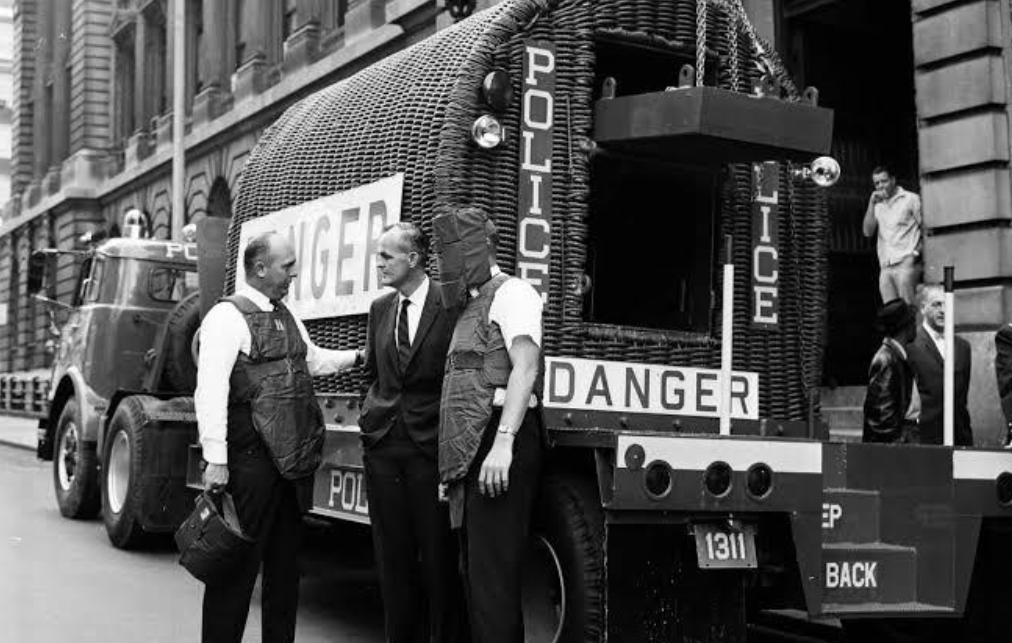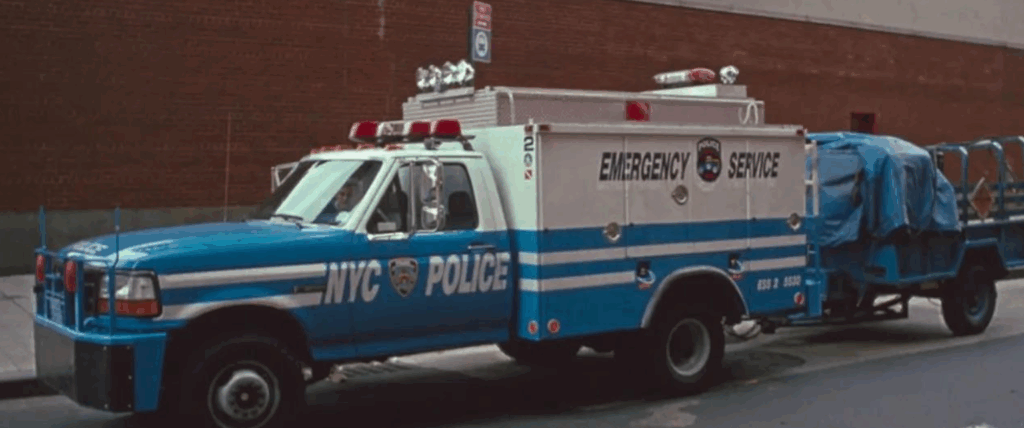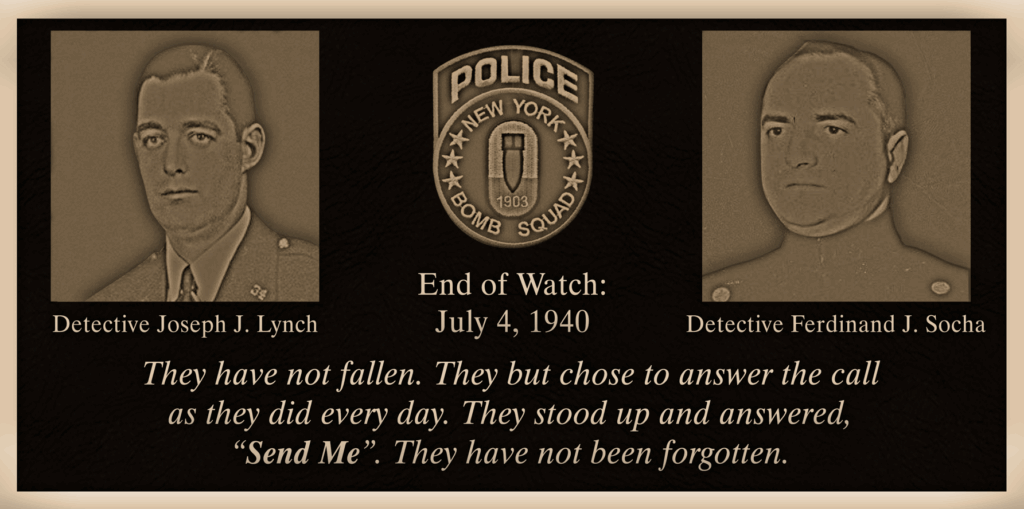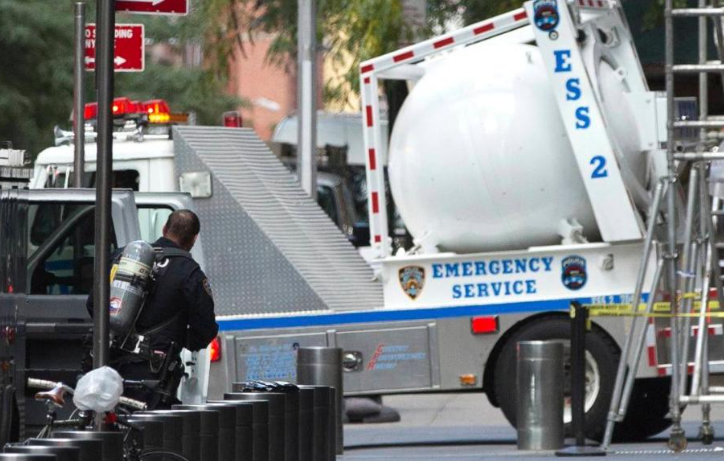![]()

The E-Files: ROLLING SAFE: THE NYPD’S TOTAL CONTAINMENT VESSEL AND THE EVOLUTION OF BOMB DISPOSAL
When the familiar blue-and-white trucks of the NYPD’s Emergency Service Unit and Bomb Squad roll through New York City streets, they’re often met with a mixture of curiosity and quiet respect. Few pieces of equipment command that reaction quite like the Total Containment Vessel, or TCV — a massive, steel-armored sphere that embodies decades of hard-earned experience and life-saving innovation.
It may look like something from science fiction — a great silver orb mounted to a flatbed, its circular door gleaming beneath the city lights — but the TCV’s purpose is rooted in the most pragmatic of missions: to contain danger, protect life, and deliver calm amid chaos.
From the LaGuardia-Pyke Bomb Carrier to the Modern TCV
Long before the TCV became a staple of modern bomb disposal, the NYPD’s Bomb Squad relied on a much simpler tool — the LaGuardia-Pyke Bomb Carrier, introduced in the mid-20th century. Named for New York City’s feisty Mayor, Fiorello LaGuardia and the Commanding Officer of the Bomb Squad, Lieutenant James Pyke. The carrier was little more than a heavily reinforced, steel-lined chamber mounted on wheels, designed to carry recovered explosives from a scene to a safe detonation range.

Bomb techs discus wearing ‘protective’ gear
In its day, the carrier was revolutionary. It gave the NYPD’s Bomb Squad — already the oldest and most experienced municipal bomb unit in the world — a way to remove live ordnance from crowded city streets without endangering the public. It became a familiar sight during the 1950s and ’60s, when the city saw a spate of politically motivated bombings and hoaxes that kept technicians on constant alert.

A remote mobile investigator (RMI) places a suspicious device into the bomb tank for placement inside the carrier during a training exercise
But as the decades passed and both the threat landscape and technology evolved, so too did the need for a more sophisticated containment system. By the 1980s, when the Bomb Squad and ESU began facing everything from unstable commercial explosives to improvised devices crafted with foreign precision, the LaGuardia-Pyke carrier — reliable as it was — had reached its limit.
Enter the Total Containment Vessel: a new generation of armored containment designed to absorb, neutralize, and transport explosive threats with near-total safety.
A Partnership Forged in Trust
The TCV’s operational use is a perfect illustration of the seamless cooperation between the Emergency Service Unit and the NYPD Bomb Squad. When a suspicious device is discovered, ESU’s Emergency Truck personnel are often the first on scene, securing the area, setting up perimeters, and standing ready to support the Bomb Squad’s technicians.
Once the device is evaluated, rendered safe for transport, and prepared for movement, ESU assists the Bomb Squad in loading it into the TCV. The sphere is then sealed, mounted, and escorted — often under heavy police protection — through the city’s arteries to the Bomb Squad’s home base at Rodman’s Neck in the Bronx. There, technicians can safely examine or detonate the device at the range, far from the crowds of Midtown or the boroughs’ narrow streets.
It’s a system that reflects discipline and precision — a choreography between two of the NYPD’s most specialized units, honed through decades of shared experience and mutual respect.
The United Nations Letter Bombs — January 13, 1997
One of the most historically significant deployments of the TCV came on January 13, 1997, when the NYPD Bomb Squad was called to the United Nations Headquarters in Manhattan after the discovery of four letter bombs mailed from Cairo, Egypt. Each device was addressed to officials at the U.N., containing enough explosive material to maim or kill anyone who opened them.
Working alongside the Emergency Service Unit, the Bomb Squad safely retrieved the packages and loaded them into a TCV for transport to Rodman’s Neck. It was a textbook example of coordination, composure, and professionalism — executed under the full glare of international media and global scrutiny.
That operation not only prevented potential tragedy but also demonstrated the quiet heroism of the ESU officers and Bomb Squad detectives who carry out this work — often in anonymity, often at great personal risk, and always with New York City’s safety as their first priority.
Post-9/11 and the Expanding Role of the TCV
In the years following the September 11th attacks, the city’s vigilance toward explosives reached an all-time high. The TCV became an even more frequent presence — whether responding to suspicious packages in the subways, abandoned luggage near courthouses, or high-profile bomb threats across the five boroughs.
A notable instance came in September 2016, when a pressure-cooker bomb detonated in Chelsea, injuring dozens. A second undetonated device was located nearby and carefully secured by the Bomb Squad, transported within a TCV, and rendered safe at Rodman’s Neck. Images of the massive vessel rolling down Manhattan’s avenues under heavy escort became an emblem of controlled calm amid chaos.
Over the years, the NYPD’s Bomb Squad has expanded its containment fleet, adopting newer TCVs with advanced features — thicker armor, greater blast-pressure tolerance, and even the ability to contain chemical or radiological material if necessary. Each upgrade reflects both technological progress and the lessons written in the unit’s history books, earned one tense callout at a time.
A Legacy of Quiet Confidence
What makes the TCV so emblematic of the Bomb Squad and ESU’s spirit is that it isn’t loud, flashy, or fast. It doesn’t rush toward the camera or the crowd. It simply does its job — quietly, deliberately, flawlessly.
It stands as the modern descendant of the LaGuardia-Pyke carrier, born of necessity and refined through decades of experience. And it continues to symbolize the very essence of the NYPD’s specialized response culture: restraint, intelligence, and professionalism under pressure.
Each time that armored sphere moves through the city, it represents countless hours of training, a network of trust between units, and an unspoken promise — that even in the face of danger, New Yorkers can go about their day in safety.

Much smaller in size makes maneuvering through New York street slightly easier
From Steel and Sweat, Safety Is Forged
The next time you see that massive silver globe mounted on a truck, escorted by flashing lights and stoic officers, remember what it carries — not just the possibility of danger, but the assurance of expertise. It’s the product of generations of officers who’ve spent careers mastering the art of safety through science and courage through discipline.
The Total Containment Vessel may be built of steel, but what truly fortifies it is the steady hand of the NYPD Bomb Squad and the steadfast support of the Emergency Service Unit. Together, they form a living bridge from the days of the LaGuardia-Pyke carrier to the cutting-edge response vehicles of today — a lineage of innovation forged not in labs or factories, but in the streets of New York itself.
Today’s updated LaGuardia-Pyke
Epilogue
In April 2022, after a year long project, the two weather beaten and rusty LaGuardia-Pyke Bomb carriers were dedicated to the two bomb technicians killed at the 1940 World’s Fair. Two identical bronze plaques, sponsored and created by REMA, were permanently mounted on each bomb carrier, forever reminding us of the sacrifice made by Detectives Joseph Lynch and Ferdinand Socha.


Mike can be contacted by phone: 917-781-6189 and email: thecolonreport@gmail.com
Podcast: https://podcasts.apple.com/us/podcast/micd-in-new-haven/id1347647537
YouTube Channel: https://youtube.com/@MCsAudio
Website: https://mike-colon-media.com

